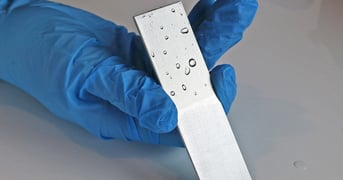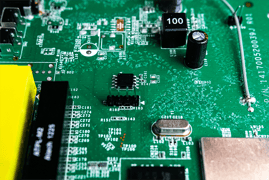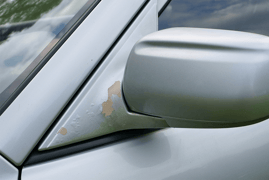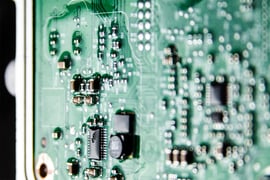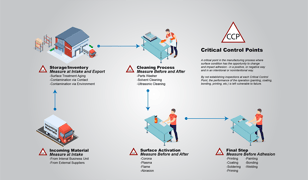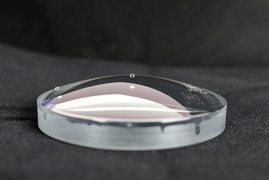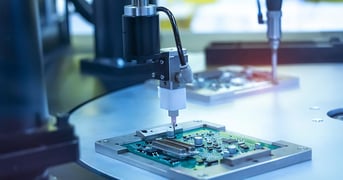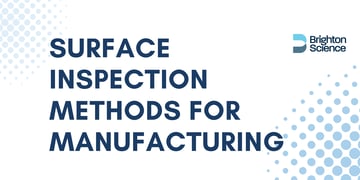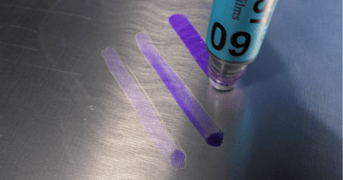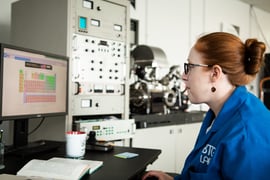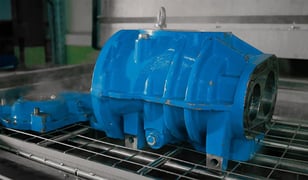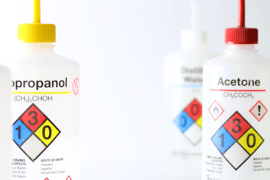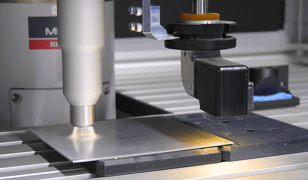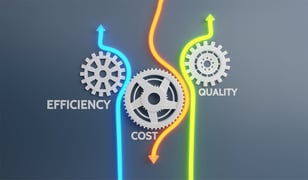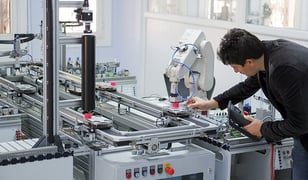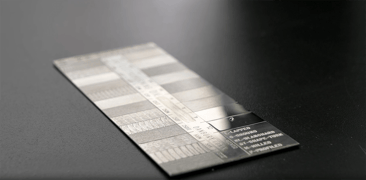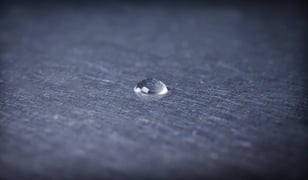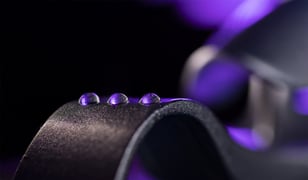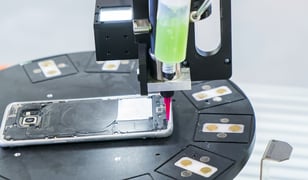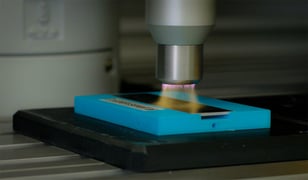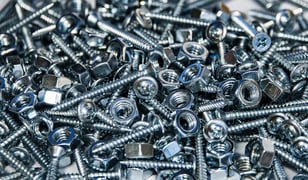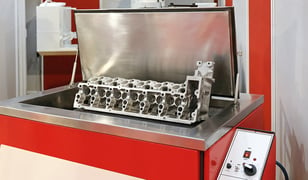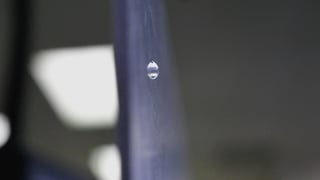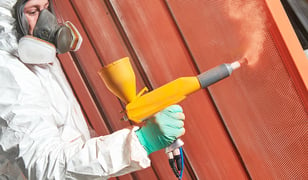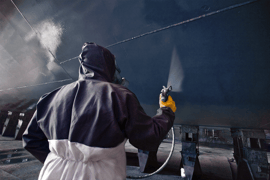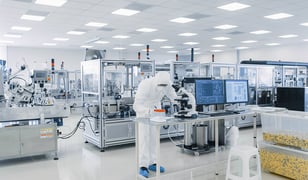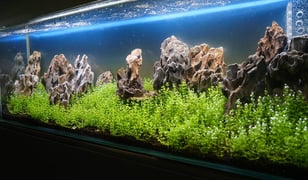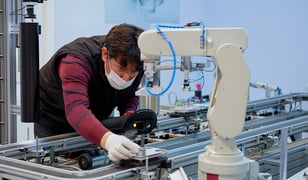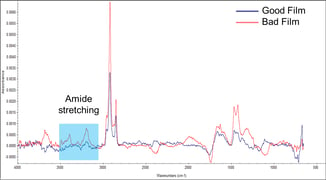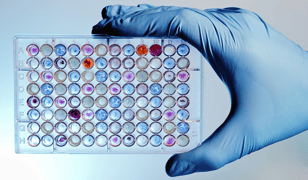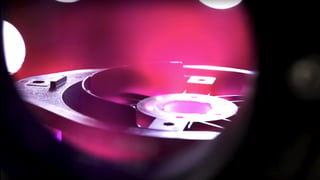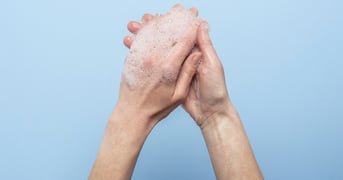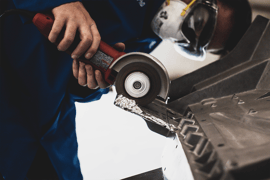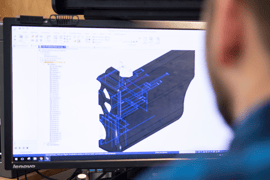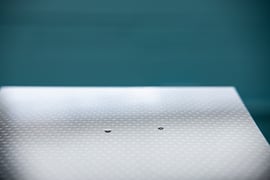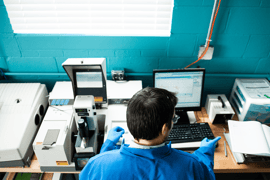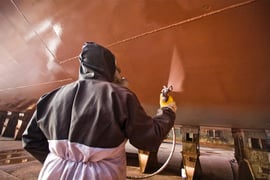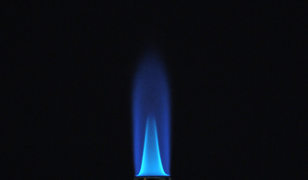What are Surfactants and How Do They Impact Surface Tension?
Key Takeaways: Surfactants are chemical compounds that lower a liquid's surface tension, allowing it to spread and interact with solids more easily. They are essential ingredients in cleaners, coatings, adhesives, and inks, but residual surfactants left behind can contaminate surfaces and weaken...
Read
Topics:
Posts by Topic
The Water Break Test as a Surface Measurement Gauge
Key Takeways The water break test is a simple, traditional method for assessing surface cleanliness, but it is subjective and limited in precision. It only detects hydrophobic contaminants and cannot quantify surface energy or detect hydrophilic residues such as surfactants. Because results are...
Read
Topics:
How the Surface Intelligence Maturity Model Prevents Adhesion Failures and Reduces Manufacturing Costs
Executive Summary: Why You Need the Surface Intelligence Maturity Model Manufacturers across industries are losing millions to unseen surface issues that cause adhesion failures, recalls, and rework. Brighton Science’s new Surface Intelligence Maturity Model gives organizations a clear, five-stage...
Read
Topics:
Ensuring Conformal Coating Reliability with Surface Intelligence
The Crucial Role of Conformal Coatings in Electronics Electronic components are the backbone of modern technology, from implantable medical devices and navigational equipment to sensor packages in cars and everyday cell phones. These delicate and exposed pieces are vulnerable to various...
Read
Topics:
Managing Critical Control Points and Adhesion Failures with Next-Gen Technology
Bond failures remain a significant challenge for manufacturers, occurring on a large scale every week despite widespread awareness of the importance of surface readiness in bonding processes like sealing, coating, cleaning, and painting. Why? Because controlling adhesion throughout every...
Read
Topics:
The Hidden Factor in Product Performance: Why the Top Few Molecular Levels of a Surface are Critical to Product Reliability
Manufactured and assembled products almost always require adhesion or cleaning steps—whether bonding, coating, painting, or printing—which makes the quality of those surfaces essential to the product's final performance. Contrary to conventional assumptions, surfaces are highly variable and...
Read
Topics:
What Automotive Manufacturers Need to Know About Surface Analysis for Polymer Bonding and Coating
Polymers have taken center stage in automotive manufacturing. Their light weight, durability, and versatility make them ideal for many applications ranging from dashboards and door panels to bumper facias and fenders. However, as any product development or quality control professional will tell...
Read
Topics:
Top 5 Strategies for Manufacturing Plant Managers to Overcome Challenges
Leadership of a manufacturing plant demands exceptional skill. Plant managers navigate a dynamic landscape of ever-evolving responsibilities. Drawing on a decade of collaboration with hundreds of companies across countless operational challenges, we've identified key insights to help tackle these...
Read
Topics:
4 Common Factors that Impact Conformal Coating Adhesion
The widespread use of electronics in all manufacturing sectors has presented distinct difficulties. Manufacturers are responsible for safeguarding these electronic devices in harsh conditions that render electronics susceptible to even the slightest traces of moisture, particles, and environmental ...
Read
Topics:
How to Control Your Adhesive Process: Find the Critical Control Points
In today's highly competitive manufacturing environment, controlling the adhesive process is vital to ensuring product quality, consistency, and efficiency. Understanding the Critical Control Points (CCPs) within the adhesive process is essential for maintaining control and achieving desired...
Read
Topics:
On the Surface: An Overview of Surface Types and Measurement Challenges in Manufacturing
Of all the challenges manufacturers face, creating and optimizing critical surface processes for various materials can be very difficult. Traits such as location, size, shape, and texture can add to the challenge. The success of any critical surface process requires an in-line, fast, easy, and...
Read
Topics:
Adhesive Bonding vs. Mechanical Fastening in Product Design: The Pros and Cons
When creating their next innovative product, designers, and manufacturers strive to achieve optimal performance while minimizing assembly and materials costs. In this pursuit, they often focus on optimizing material usage. In the quest to achieve optimization, it is uncommon for excess materials to...
Read
Topics:
Surface Inspection 101: A Visual Guide to the Surface Analyst, Water Break Tests, and Dyne Ink
In the manufacturing industry, it is crucial to meet certain surface preparation requirements in order to ensure the safety and reliability of products. Various tests have been developed to determine if these requirements are being met and if the cleaning process has been effective enough to...
Read
Topics:
Surface Energy Measurement is the Key to Process Control and High Performance
When manufacturing companies take adhesion seriously, they can significantly improve their ability to achieve their business goals. The key is to take a strategic look at adhesion processes early in product development.
Read
Topics:
What is Materials Science & Why is it Crucial for New Product Development?
Many people are not familiar with the subject matter and discipline of materials science because it’s not taught in elementary or high school and only infrequently at the university level. Instead, we are often taught chemistry and physics. Chemistry teaches us how atoms and molecules interact,...
Read
Topics:
Guaranteeing Anti-fog Coating Application on Automotive Headlights
The competitive nature of the automotive industry requires manufacturers to engineer the ideal product; failures, no matter how small, are unacceptable and can bring heavy consequences.
Read
Topics:
Surface Analyst Technology Replaces the Old Language of Dyne Ink
For over a decade, manufacturers and suppliers have spoken the language of dyne when dealing with surface preparation and treatment verification. Because the process of dyne analysis requires users to interpret the way the ink spreads on a surface, it is highly subjective, making the language of...
Read
Topics:
The Relationship Between Total Quality Management Systems and Sustainability
In the age of sustainability practices becoming more of the norm, there are a few ways in which your company can both abide by new regulatory standards concerning sustainable changes to the chemicals used and have a positive impact on your total quality management standards.
Read
Topics:
How Surface Intelligence Can Improve Your Return on Investment
“For every company, its competitiveness comes from its ability to assimilate knowledge and failure - which I tell my kids all the time - failure is an opportunity to learn and feedback is a gift. And if we take the 'quick fix' we take the learning off the table.” Andy Reeher, CEO, Brighton Science
Read
Topics:
Guess the Contact Angle: IPA Wiped Composite Material
This 'Guess the Contact Angle' video is the first of our next series of videos focusing on how contact angle changes when a composite surface is cleaned or treated in various ways. The contact angle featured in this demo is formed by a water droplet deposited using the handheld Surface Analyst on...
Read
Topics:
Why a Surface Chemistry Input Should be Included in New Product Specifications
When development teams are looking to build a new product that includes a coating, bonding, painting, or sealing process, it's only natural to consider what kind of adhesive, coating, or paint will perform the best. While these selections are critical to the end product's success, development teams...
Read
Topics:
What Does Surface Intelligence Look Like in Action?
Surface condition is a significant driver of process and product reliability. It affects every part of the product life cycle, from development to launch, and its impact continues for as long as the product remains in service.
Read
Topics:
Importance of Adhesion & Composites in Lightweighting Cars
One of the most pressing questions on the minds of manufacturing engineers is how to take a load off. Lightweighting, or shedding pounds on assembled vehicles and machinery, is a critical puzzle in aerospace, marine, and, most acutely, automotive industries. In fact, with the pressure to optimize...
Read
Topics:
What are the Primary Causes of Chronic Adhesion Failures?
Adhesion problems tend to appear in the manufacturing process and then overstay their welcome. The chronic nature of so many adhesion issues is due to factors that many manufacturing companies are oblivious to. That’s not to fault the manufacturers. Until recently, there hasn’t been a reliable way...
Read
Topics:
Boost New Product Innovation Using Materials Science and Technology
Having the freedom to design and build to the limits of our imaginations is at the core of what makes us human. You must think outside the common practice to boost innovation and improve processes to accomplish this task.
Read
Topics:
The Best Way to Qualify a Wash Method for Your Manufacturing Process
Parts washers are heavy-duty, hardworking machines that have become irreplaceable staples in automotive andmachined part manufacturing processes. As manufacturing processes have become more sophisticated, the industries using parts washers have expanded to includenot only industrial metals and...
Read
Topics:
Why You Should Implement a Surface Cleanliness Specification Using Contact Angle
When cleaning invisible contaminants from a surface, you may ask yourself, "How do I know when the surface is clean, or how clean, is clean enough?" These are common questions that product development teams ask when developing new products that require surfaces to be thoroughly cleaned in order to...
Read
Topics:
Guess the Contact Angle: Plasma Treated Aluminum
So far in our Guess the Contact Angle Series, we have brought you three videos demonstrating how contact angle changes depending on the state of the material surface: Contact angle measurement on a piece of aged, 'as is' aluminum Contact angle measurement on aluminum after cleaning it with an IPA...
Read
Topics:
What Is the Role of Surface Chemistry in Industry?
Manufacturing has become increasingly complex with the fusion of technologies that are blurring distinctions between the digital, physical, and biological worlds. Physical products and services have transformed significantly due to enhancements made possible by digital capabilities. New...
Read
Topics:
The Benefits of Benchmarking Surface Quality in Manufacturing
Certainty is the goal of every manufacturing process. Manufacturers must have total confidence that every aspect of their production process will go according to plan. The adhesion process needs to be controlled just like any other production operation, with accuracy and ongoing monitoring....
Read
Topics:
Does Your Organization Take A Holistic Approach to Innovation?
Innovation can be a scary thing. For companies built on order, predictability, and success, innovation can be unsettling. It can be messy, unpredictable, and prone to failure before producing a demonstrable payback. But innovation is vital. Without it, there can be no evolutionary growth or...
Read
Topics:
Guess the Contact Angle: Abraded Aluminum
So far, in our Guess the Contact Angle Series, we have brought you two videos: the first one shows the Surface Analyst taking a contact angle measurement on a piece of aged, 'as is' aluminum. The second video asks you to guess the contact angle after we took the same piece of aluminum but cleaned...
Read
Topics:
Meet Brighton Science's Chief Scientist, Giles Dillingham
A Deep History in Materials Science Founder and Chief Scientist of Brighton Science, Dr. Giles Dillingham's fascination with the connections between the invisible (the molecular structure of the world around us) and the perceivable (the properties and behavior of materials and objects) stems from a...
Read
Topics:
Top Challenges Product Development Teams Experience When Bringing a Product Concept to Manufacturing
Modern product development is fraught with challenges due in large part to the sophistication and complexity of the various elements that go into a final product – everything from materials and surface geometries to coatings, bonding, and even staff skills and competencies. Pitfalls await even the...
Read
Topics:
Does Surface Roughness Impact Contact Angle Measurements?
When measuring and quantifying surface energy, a common question arises: "Does surface roughness impact contact angle measurements obtained by the Surface Analyst?" In response, Surface Intelligence experts at Brighton Science launched a research project to determine whether contact angle...
Read
Topics:
Surface Preparation for Primer Coating of Composites in Aerospace Applications
Achieving a flawless, long-lasting paint job on an aircraft is a complex undertaking. This multi-stage process starts well before the final coat graces the wings and tail. Components are meticulously molded, prepared (often involving multiple steps), assembled, and then coated with primers and...
Read
Topics:
Top 5 Trends in Products & Manufacturing Today
Change is perhaps the one absolute constant in manufacturing. Developments - in materials, processes, machinery, testing, products, markets, and thousands of other things affecting manufacturing companies - happen daily.
Read
Topics:
Guess the Contact Angle: IPA Wiped Aluminum
As part of the Guess the Contact Angle series, we have brought you a new video that highlights best practices when cleaning material surfaces with IPA wipes and we will ask you to "guess" the contact angle measurement after the surface has been cleaned. The contact angle featured in this demo is...
Read
Topics:
Contact Angle Measurements Guide Better, Data-Driven Quality Decisions
Deciding whether to reject a part or not based on a quality measurement always carries with it a finite risk: you could unknowingly decide that a perfectly good part is actually bad (a Type 1 error), or you might incorrectly conclude that a bad part is actually good (a Type 2 error). There is a...
Read
Topics:
Eliminate Surface Engineering Challenges & Design with Freedom
Oftentimes, to boost innovation and improve processes, you have to think outside the common practice. You have to take the restraints off of creativity. Freedom to design and build to the limits of our imaginations is at the core of what makes us human.
Read
Topics:
How to Master Industrial Adhesion with Scientific Predictability
Manufacturers who produce products with surfaces that require paints, adhesives, or sealants face a challenge in determining the quality and reliability of the final product. The problem is often caused by the fact that most manufacturers don’t have complete control over three critical elements of...
Read
Topics:
How Manufacturers Can Optimize the Effectiveness of Plasma Activation
In last week’s blog post, Using Plasma for Surface Cleaning and Activation, Rose Roberts, Ph.D., Brighton Science's (formerly BTG Labs) Senior Custom Applications and Materials Engineer, discussed how to use plasma for the dual purposes of cleaning critical surfaces and activating critical surfaces...
Read
Topics:
Using Plasma for Surface Cleaning and Activation
This blog post is the first of a two-part series focusing on plasma. With the help of Rose Roberts, Ph.D., Senior Custom Applications and Materials Engineer, we will review plasma basics and discuss how plasma can be used for both cleaning and surface activation. We will also touch upon the...
Read
Topics:
Surface Measurements Help Coating and Plating Suppliers Guarantee Quality
Automotive supply chains are complex. Nearly 78 million vehicles were manufactured in 2020. Each vehicle may have upwards of 30,000 individual parts. Automotive original equipment manufacturers (OEMs) need to manage billions of parts annually. If any of these parts fail, vehicle performance is...
Read
Topics:
Quantifying the Effectiveness of High Volume Metal Cleaning in Fresh and Aged Baths
In today’s video, we will show you how to quantify the surface quality of metals when using fresh and aged baths. We will demonstrate how Water Contact Angle (WCA) measurements can provide feedback in less than two seconds on the effectiveness of your cleaning process and will enable you to improve...
Read
Topics:
Guess the Contact Angle: Aged 'as is' Aluminum
In today’s blog post, we are going to have a bit of fun using video to learn more about contact angles. We will show you a contact angle and will ask you to “guess” the contact angle measurement. The contact angle featured in this demo is formed by a water droplet deposited on a piece of ‘as is’...
Read
Topics:
Why Knowing Water Contact Angle is Important for Successful Adhesive Performance
Adhesives are an integral part of modern manufacturing, but choosing the right adhesive is only one part of the equation. It’s well known that you won’t get a reliable bond with an adhesive if you just slap the adhesive onto your material without doing anything to prepare that surface. What ISN’T...
Read
Topics:
How to Prevent Coating Failure and Corrosion in Polymeric Materials
These days, if you see a painted product, it is likely a polymer-based coating providing a striking and powerful barrier between the underlying material and elements in the atmosphere that want to corrode that material. Polymer coating technology has advanced tremendously in the last decade....
Read
Topics:
Topcoat to Primer Surface Reliability for Aircraft Painting
Adhesion problems don’t have a preference when it comes to the kind of damage they cause. Whether the end result is structural or cosmetic, adhesion-related failure headaches for manufacturers abound. One of the most crucial aesthetic operations for aircraft OEMs is the topcoat of paint, although...
Read
Topics:
What Medical Device Manufacturers Need From Surface Cleanliness Testing
Quality tests during medical device production need to check a lot of boxes for manufacturers. Testing must increase confidence in product reliability in order to be worthwhile to manufacturers. What’s more, that confidence needs to be measurable and reportable because companies cannot tolerate...
Read
Topics:
Surface Preparation for Reliable Optical Coatings in Photonics Manufacturing
Coatings are an indispensable part of manufacturing photonics. The coatings help determine the most basic functionality of the lenses they are applied to. How much light passes through, what happens to that light when it passes through the lens, does some light get absorbed, and are some spectral...
Read
Topics:
How to Control Surface Quality for Bonding Dissimilar Materials
We’ve mentioned many times in various articles that bonded material systems are becoming the norm for manufacturers in nearly every industry. In order to make finished products more efficient in terms of weight, cut material costs, accommodate more automated processes, lessen the need for repairs...
Read
Topics:
COVID-19 Makes Remote Quality Monitoring Crucial for Manufacturers
Since COVID-19 has reshaped the economic landscape for the foreseeable future and there are many questions about how to safely and effectively respond to it, now is a good time for manufacturers to consider how to make the best of our “new normal” if they haven’t already done so in earnest.
Read
Topics:
How to Bond Fiber Reinforced Plastics for Harsh Environments
Many manufacturers have a dual performance concern when their products are out there in the world being used in whatever capacity they were designed for. These parallel interests are: how to maintain the appearance and how to guarantee structural integrity through common usage of the products.
Read
Topics:
The Dangers of Missing Vital Surface Quality Information in Production
A major problem for manufacturers is the problem of sensitivity. There is a rampant lack of sensitivity to material surfaces for companies across every manufacturing industry. Granted, it’s not easy to test surface quality to predict the outcomes of common manufacturing processes like adhesive...
Read
Topics:
The Best Way to Verify Medical Diagnostics Coatings
The biomedical industry runs on testing. Testing is at the heart of meeting extensive requirements to ensure healthcare practices and facilities are safe. A kind of testing that has been on all of our minds lately is the kind of testing that analyzes the presence of diseases. Often these tests...
Read
Topics:
How to Protect Overmolded Connectors for Medical Devices
Protective coverings are part and parcel of our lives these days. For industries reliant upon electronic components and connectors, protective coverings in the form of polymeric over-molding encapsulation need to remain sealed and impervious to the environment.
Read
Topics:
How to Get the Most Out of Your Vacuum Plasma Treatment
Vacuum plasma is the treatment method of record for many manufacturers. Not only because it is a legacy technology proven useful over many, many decades but because it can be particularly effective at creating chemically reactive surfaces of various geometries that need to be bonded, coated,...
Read
Topics:
Covid-19: Biological vs. Chemical Contamination in Manufacturing
Lately, the whole world has seen variations of the same conversation. Whether the discussion centers on N95 masks, toilet paper, hand sanitizer, disinfecting wipes, or what movies to watch while maintaining a safe social distance, the underlying concern is about cleanliness.
Read
Topics:
Is Roughness as Important as Surface Cleanliness to Adhesion?
When manufacturing engineers discuss material surfaces, they usually focus on their physical attributes, such as surface topography or morphology or, more simply, surface roughness. Preparing material surfaces for assembly, coating, painting, or adhesive bonding typically includes steps that...
Read
Topics:
The Tools & Skills to Address Adhesion Problems in Production
When adhesion issues become apparent in a manufacturing process, they can seem to come out of nowhere. When coatings on circuit boards delaminate and cause shorts, when automotive glass doesn’t properly seal and moisture is let through, or when implantable medical devices aren’t meeting cleanliness...
Read
Topics:
Best-practice Surface Preparation Processes for New Products
New Product Development is an essential component to the successful growth of companies that always challenge themselves to improve and innovate. Getting this design stage right is pivotal in that it sets in motion everything the product will be and how well it will perform.
Read
Topics:
How to Know if a Manufacturing Surface is Treated or Untreated
In order to ensure successful bonding, coating, printing, painting, laminating or meet cleanliness standards in manufacturing, material surfaces must be manipulated. One such manipulation that gets surfaces ever closer to being ready for adhesion is surface treatment. There are many operations and...
Read
Topics:
How to Transfer a Lab Surface Treatment Process to Production
Production processes don’t just materialize fully formed on the manufacturing floor. Procedures and operations go through a full research and development cycle, which can take years before they are integrated into the production line. This pre-production work includes strength, reliability, and...
Read
Topics:
Secrets to Predicting Adhesion Failures in Production
When adhesion failure becomes apparent in manufacturing processes, it can seem to come out of nowhere. Very often, there is no problem until suddenly there is. It feels unpredictable, unavoidable, and like the best solution is to either eat the loss it brings or just hope it goes away as quickly...
Read
Topics:
Deck the Hulls: Preparing Ship Hulls for Coating and Painting
Manufacturing a product to withstand the environmental stresses of wind, rain, and sediment is challenging enough. But, when you add saltwater and wave action to the mix, the detrimental threat of corrosion increases significantly. A coating adhesion test is important for quickly testing a surface...
Read
Topics:
Surface Treatment Processes: Flame Treatment
Flame treatment is a surface activation treatment process used to chemically modify a surface for better adhesion. This process is typically used on low-energy surfaces that can be difficult to adhere to, such as plastics and composites. The treatment is also very gentle, posing low risk to the...
Read
Topics:



